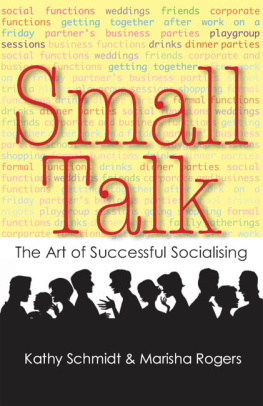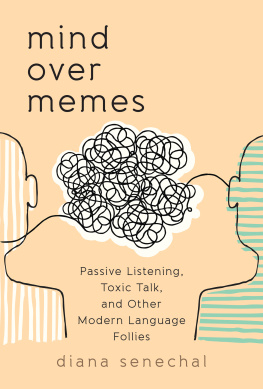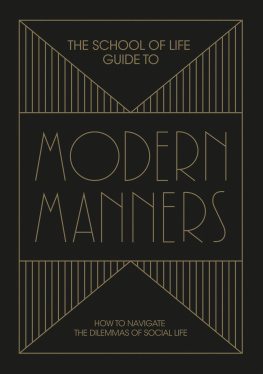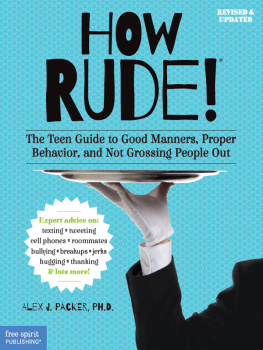Small
Talk
The Art of Successful Socialising
Kathy Schmidt
&
Marisha Rogers
To all those struggling social
wannabes who dream of
a thriving social life
First published in Australia in 2008 by
New Holland Publishers (Australia) Pty Ltd
Sydney Auckland London Cape Town
www.newholland.com.au
1/66 Gibbes Street Chatswood NSW 2067 Australia
218 Lake Road Northcote Auckland New Zealand
86 Edgware Road London W2 2EA United Kingdom
80 McKenzie Street Cape Town 8001 South Africa
Copyright 2008 in text: Kathy Schmidt and Marisha Rogers
Copyright 2008 New Holland Publishers (Australia) Pty Ltd
All rights reserved. No part of this publication may be reproduced, stored in a retrieval system or transmitted, in any form or by any means, electronic, mechanical, photocopying, recording or otherwise, without the prior written permission of the publishers and copyright holders.
National Library of Australia Cataloguing-in-Publication Data:
ISBN: 9781741106190 (pbk.).
eISBN: 9781921655265
Preface
The idea for this book came from a conversation I had with my mother. She had been invited to a dinner party with some high-profile people, all with interesting backgrounds, world experience and sound general knowledge. She thought she would be out of her depth and have nothing to offer for conversation. Mum can hold her own in any situation as her general knowledge is vast from a lot of reading and many hours listening to the AM radio talk back shows. She always appears interested and is forthright in getting conversations going. Yet she still felt nervous.
For some people shyness in a social gathering comes from the belief you are unable to contribute anything enlightening or relevant to the conversation, or from the fear of appearing stupid. If you have been out of the work force for several years raising young families or have been otherwise kept from regular social events, you often find that you are no longer confident and have lost the art of socialising. Many people feel this way.
This book will give you the insight and inspiration to deal with all aspects of social functions. Drawing on experience, both good and bad over the years, combined with practical information, this book will help you feel confident and prepared to embrace any social gathering.
Acknowledgments
We would like to thank the following family and friends who have helped colour this book with their personal stories: Sean Rogers, Steve Schmidt, Lindy and John Sieveking, Nick Sieveking, Daniel Sieveking, Judy Potter, Victoria Schmidt, Suzique Doughty, Michelle Elliott, Lyndell Hart, Mel Sheath, Jane Phillp. Small Talk is all the better for them.
Contents
LOOKING
GOOD
I speak two languages, Body and English.
unknown
Body language speaks louder than words. Research has shown a huge 5570 per cent of the way we communicate is through this means. Even when speaking, our message is conveyed more through our vocal tones than the actual meaning of the words we use. Unlike words, which can be twisted to mean anything if we try hard enough, body language is usually on an unconscious level and conveys what we are really feeling. Once you are familiar with what message you are sending with your body language, it becomes easier to change it to reflect the message you want to portray. It is perhaps our most powerful form of communication. It can help facilitate conversation, diffuse awkward situations and put people at ease. It will also assist you in persuasion, influence and making friends quickly and allows you to detect the message someone is sending you. Body language can help us interact with people from other cultures when language becomes a barrier.
Very few of us are an open book, where we blurt out exactly how we are feeling and what we are really thinking. We can be saying one thing, while at the same time, thinking something completely different. Generally we choose our words very carefully in order to avoid hurting someones feelings or to mask our own. From the smallest gesture to the way we enter a room, we speak volumes about how we feel about ourselves. Your level of confidence or self-worth will determine how others treat you. To gain someones trust and friendship they need to feel comfortable with you.
The way our eyes move in a certain direction when asked a question, our posture, facial expressions, and gestures reveal whether we are telling the truth, are uncomfortable, shy, nervous or simply not interested. You can discover if someone is attracted to you or use it to create romantic interest in someone you desire. It helps us communicate both subtle and complex meaning. Learning the art of reading body language could put you at a huge advantage whether with friends, work colleagues or new acquaintances. You can use these skills to make you appear more confident, charismatic, interesting and to command respect. Reading the body language of others will help you to detect what they are feeling and you can adjust your approach or the course of conversation until you get the desired effect.
Easier said than done? Well, we need to start somewhere, and these basic skills in body language will help you the next time you find yourself in an awkward situation at a social gathering. You may even surprise yourself and really start to enjoy meeting new people and discovering how they react to things. On the other hand it may be quite alarming when you discover that others arent interested in you, or that talking to you is a chore. You may be familiar with the scan, when you are talking to someone but they are constantly scanning the room for someone else to talk to, hoping to make an escape. I have been on both sides of that equation, and it is uncomfortable either way.
The impression you make as you enter a function can determine the effect you will have on people for the rest of the event. If you appear confident and self-assured, people will believe you to be so even if you are a nervous wreck on the inside. It is merely a guide, as body language can be misinterpreted, but here are some points to keep in mind.
How to enter a room
 Maintain straight and erect posture and hold your head high
Maintain straight and erect posture and hold your head high
 Make good eye contact with everyone you meet
Make good eye contact with everyone you meet
 Smileit makes you more approachable
Smileit makes you more approachable
 Nod occasionally as people talk to you to acknowledge what theyre saying.
Nod occasionally as people talk to you to acknowledge what theyre saying.
Greeting people
 Introduce yourself with a smile
Introduce yourself with a smile
 Have a firm handshake.
Have a firm handshake.
Confident postures
 Standing with your hands behind your back
Standing with your hands behind your back
 Clasping your hands gently in front of your stomach
Clasping your hands gently in front of your stomach
 Touching your fingertips together
Touching your fingertips together













 Maintain straight and erect posture and hold your head high
Maintain straight and erect posture and hold your head high